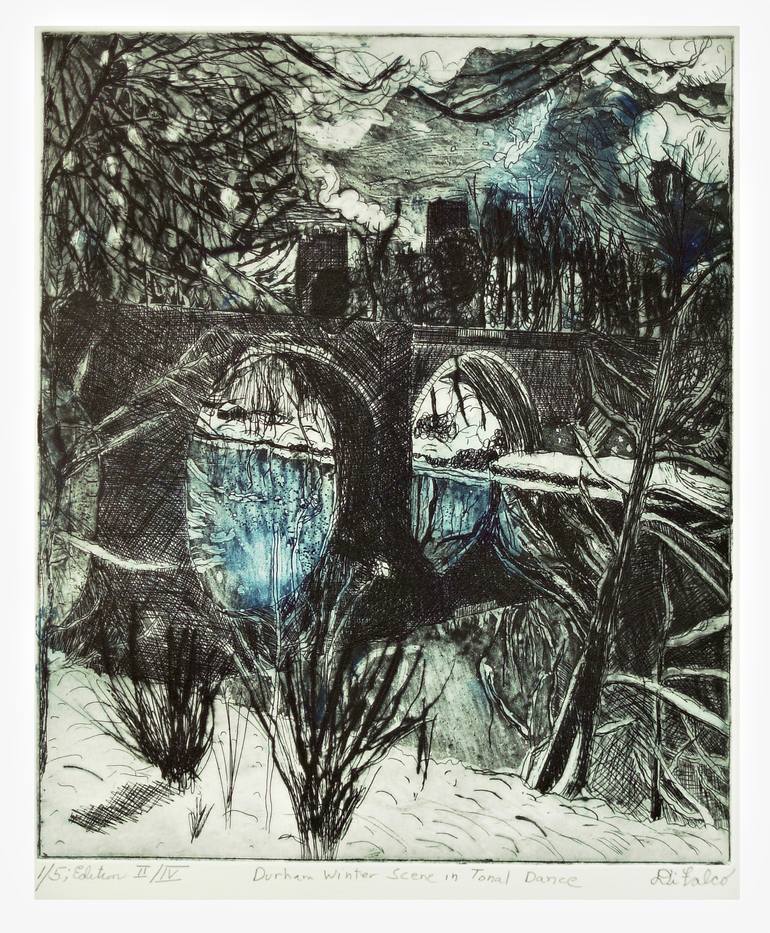


VIEW IN MY ROOM
DURHAM: WINTER SCENE IN TONAL DANCE - Limited Edition 2 of 4 Print
United States
Printmaking, Aquatint on Paper
Size: 18 W x 24 H x 1 D in
Ships in a Box
Artist Recognition

Artist featured in a collection
About The Artwork
DURHAM: WINTER SCENE IN TONAL DANCE This original etching by printmaker Gerard Jerry Di Falco shows the location of a winter landscape in Durham, England; and, the scene features Durham Cathedral in the distance in a landscape of snow with a stream, clouds, bridges, and trees. The etching was inspired by an albumin print from 1865 (gifted to Cornell University by Andrew Dickson White, where it is now part of The A. D. White Architectural Photographs Collection, Cornell University Library, Accession Number: 15/5/3090.01065). Di Falco Hand-created and printed the artwork himself on a zinc etching plate and then printed it on Rives BFK white paper (France); the artist used Charbonnel brand etching inks from Paris. Five separate baths in a nitric-acid solution was required before the artist was satisfied with the plate. A Liquid Hard Ground (also Charbonnel brand) from Paris was used to apply over the zinc. This work is from a very limited Edition of only five prints; moreover only FOUR Editions will be produced. This is from EDITION TWO. Di Falco’s etching style is quite painterly as a result of his unique plate wiping and ink application techniques. The studio techniques for this work included intaglio, drypoint, and aquatint. All editions were printed at The Center for Works on Paper at 704 Christian Street in Philadelphia, Pennsylvania, US, where he is part of The Open Studio In Printmaking. Di Falco’s etching studio is located on Fleisher Art’s campus, a school on the Seven-Hundred Block of Catharine Street and connected with The Philadelphia Museum of Art. The zinc plate size is Nine inches wide by Twelve Inches High, or 22.860cm by 30.480cm; The hand-torn paper size (finished print) measures Fifteen inches wide by Seventeen inches high. THE SAATCHI PRICE INCLUDES: THE ART WORK; ALL SHIPMENT COSTS (US, REGULAR DOMESTIC); A GLASS FRAME; ARCHIVAL MATTTING; FRAMING JOB WITH CRAFT PAPER PACKING; HANDLING; ALL WRAPPING MATERIALS INCLUDING BUBBLE WRAP & GLASSINE TISSUE; PROFESSIONAL CARDBOARD SHIPMENT CARTON; AND, CERTIFICATE OF AUTHENTICITY. PLEASE NOTE THAT YOUR ART ARRIVES WIRED AND HEADY TO HANG. A WALL HOOK AND NAIL ARE ALSO INCLUDED.
Details & Dimensions
Printmaking:Aquatint on Paper
Artist Produced Limited Edition of:4
Size:18 W x 24 H x 1 D in
Frame:Black
Ready to Hang:Not applicable
Packaging:Ships in a Box
Shipping & Returns
Delivery Time:Typically 5-7 business days for domestic shipments, 10-14 business days for international shipments.
Handling:Ships in a box. Artists are responsible for packaging and adhering to Saatchi Art’s packaging guidelines.
Ships From:United States.
Have additional questions?
Please visit our help section or contact us.
United States
Imagery and storyline—both vital components of my creative process—enable me to create a form of visual poetry. Consequently, photography is intricate to my artistic strategy, especially with regard to my etchings. In view of this, many of my printed images—accomplished via the studio techniques of intaglio, aquatint, drypoint, and Chine collè—originate from my own photographs, as well as ones I uncover during research into the archives of academia, historical societies, and museums. Upon locating a scene that fascinates me, I first sketch a few original drawings of the likeness, and next transfer that drawing onto my prepared zinc etching plate. NOTE: In my etchings that incorporate the Chine collè process, I use mulberry bark paper from Thailand, which is infused with Japanese kozo threads. The paper is also treated with methylcellulose. I endeavor to establish links between the metaphysical and physical worlds . . . between the realms of dream and reality . . . and between the natural and the fabricated. In a sense, I believe that art unveils everything that we mask behind our assumptions and biases . . . or rather, those realms we neglect—or refuse—to perceive. My label for our failure to examine these areas is, “The Phenomenology of Non-Connectedness", which I blame on today’s communicational tools such as Social Media, the Internet, texting on smart phones, and “tweeting”. MY ETCHING TECHNIQUE I work on metal etching plates treated with both hard and soft grounds. These grounds consist of mineral spirits, beeswax, oil of spike lavender, and other natural substances. After these grounds dry, I draw images with needles and other tools onto the plate. Next, the exposed areas are “etched into” the zinc or copper plate in a bath of Nitric Acid and spring water. An artist’s proof in then printed after the plate is cleaned; Moreover, two to seven additional plate workings, acid baths, and proof printings occur before my desired effect is obtained. When satisfied with my end result, I apply oil based etching ink onto the clean plate and then remove the excess ink with several wipes. Next, I align my etching plate onto the printing press bed and cover it with papers and press blankets. Finally, the plate goes through the press to obtain my print. This process is repeated until all editions are created. I usually create three to five editions of five or six etchings for each one of my plates.
Artist Recognition

Artist featured by Saatchi Art in a collection
Thousands Of Five-Star Reviews
We deliver world-class customer service to all of our art buyers.
Global Selection
Explore an unparalleled artwork selection by artists from around the world.
Satisfaction Guaranteed
Our 14-day satisfaction guarantee allows you to buy with confidence.
Support An Artist With Every Purchase
We pay our artists more on every sale than other galleries.
Need More Help?